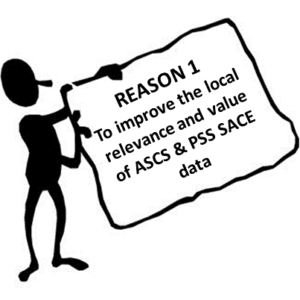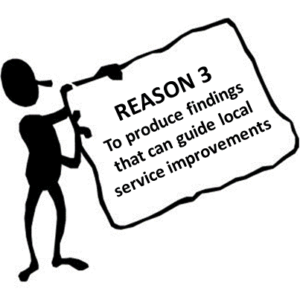WHY SPEND TIME ON ANALYSING YOUR ASCS AND PSS SACE DATASETS
The Adult Social Care Survey (ASCS) and Personal Social Services Survey of Adult Carers in England (PSS SACE or SACE, more commonly known as the Carers Survey) are conducted by all local authorities with adult social care responsibilities as part of their annual data returns to NHS Digital. As both surveys are conducted on large samples of service users and carers – and are potentially the largest pieces of local research that a LA conducts with these groups – the ASCS and PSS SACE can provide an invaluable source of outcomes information. Our research activities and consultations with LA staff, however, indicate that most focus their analysis activities on descriptive analysis (i.e. summarise of frequencies and percentages of individual response options) and direct ASCOF comparisons (e.g. over time and between organisations and the national average).
The findings from these research activities were used to inform the design and content of the MAX toolkit (please click here for an overview) and the purpose of this current blog is to summarise  the reasons why we think LAs should spend time conducting more focused analysis on their ASCS and PSS SACE datasets.
the reasons why we think LAs should spend time conducting more focused analysis on their ASCS and PSS SACE datasets.
Some of the potential ‘consumers’ of ASCS and PSS SACE data involved in our earlier activities (e.g. managers, commissioners) stated that they did not find the descriptive analysis included in survey reports useful.
As the surveys collect data on service user demographics. Focused analysis of this data can produce findings that can be used to develop service user profiles  and to identify areas of potential interest (e.g. marked change) and/or concern (e.g. areas of unmet need).
and to identify areas of potential interest (e.g. marked change) and/or concern (e.g. areas of unmet need).
Further analysis – particularly mixed analysis, which combines the findings from both quantitative (numerical) and qualitative (textual) data – can be used to answer local research questions. For example, which groups are reporting unmet needs, and why? These questions can be used to guide day-to-day practice and longer term decision-making and, in turn, may reduce the need for local research and consultation.


________________________________________
Disclaimers
This blog is based on independent research commissioned and funded by the NIHR Policy Research Programme (Maximising the value of survey data in adult social care (MAX) project and MAX toolkit implementation and impact study). The views expressed in the publication are those of the author(s) and not necessarily those of the NHS, the NIHR, the Department of Health and Social Care or its arm’s length bodies or other government departments.

Trackbacks/Pingbacks
[…] next blog discusses how LAs can use their survey data to service user and care profiles, and can be accessed here. ______________________________________ Disclaimers This blog is based on independent […]